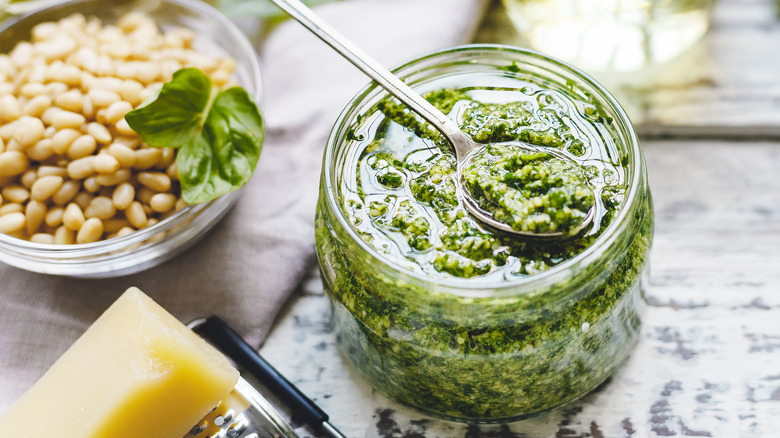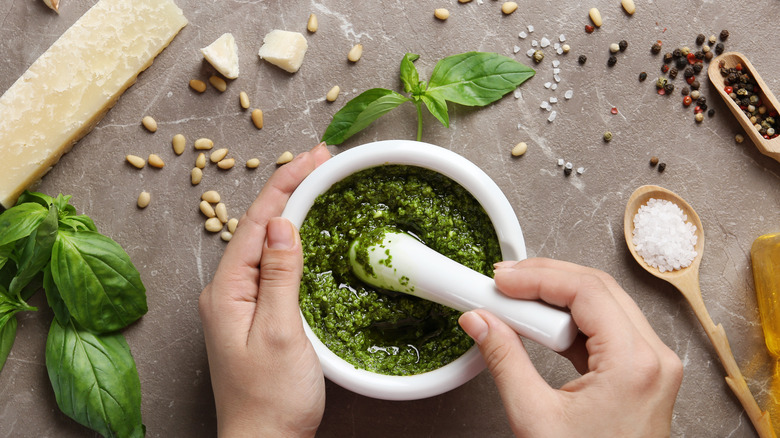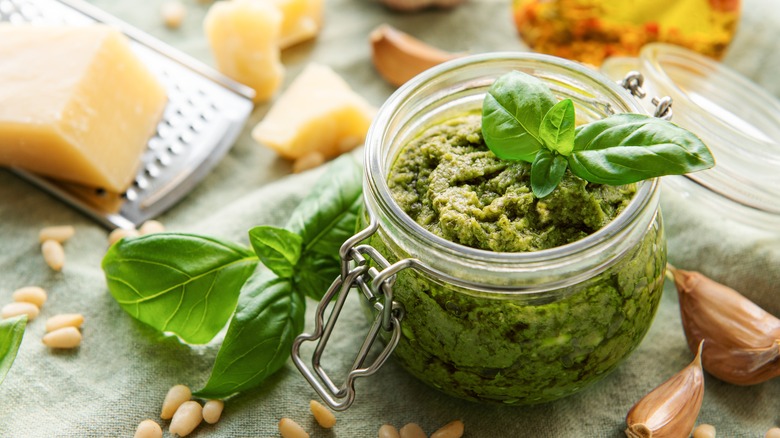The Key To Preserving Pesto's Vibrant Green Color
Vibrant pesto, with its slightly salty and herbal flavor, is a simple ingredient that can elevate any meal from standards like sandwiches and pasta to creamy dips and arancini. Typically a combination of basil, pine nuts, olive oil, garlic, and parmesan cheese, it's also easy to get creative with, making other versions like a spicy jalapeño pesto, a seasonal ramp pesto, or a nutty pistachio pesto.
However, homemade pesto has one slightly pesky problem: It tends to turn from its gorgeous shade of green to a less appealing brownish-green hue. The basil itself oxidizes quickly, so finding a way to slow that process is crucial to preserving the sauce's bright color. Fortunately, there are a few techniques that will help pesto keep its color. From blanching and adding another herb to avoiding heat and introducing citrus, you can easily adjust your pesto preparation to be sure to serve the prettiest version possible.
Easy ways to avoid browning
Just like avocados and apples, basil turns brown when exposed to air, but adding a little lemon juice can help to mitigate the issue. The antioxidant ascorbic acid is prevalent in lemon and helps to preserve the basil's bright color while also adding a zesty flavor.
"Top Chef: Portland" contestant Sara Hauman, who is also the owner of Tiny Fish Co. and formerly served as the head chef at Soter Vineyards in Carlton, Oregon, told Insider that adding parsley to pesto will help it stay green longer as well. She also recommends not warming the sauce.
"It's important to avoid heat so that the sauce stays a vibrant green color," said Hauman.
While it may seem easy to avoid the heat by just spreading pesto on sandwiches or not adding it to a hot pan of pasta, it's also important to consider the tools you're using for preparation. While pesto was originally made using a mortar and pestle, today many home cooks turn to blenders or food processors. While you can use these to make your pesto, it's ideal to do so quickly and to use a pulse function to avoid having the blender heat up, which will degrade the quality and color of the basil. It's also important to keep in mind that high-powered blenders, specifically, have the capacity to heat ingredients, which would definitely be detrimental to creating a brightly colored pesto.
Blanching and storage
A final technique that you can use to help basil retain its color is to blanch it before preparing the pesto. Heating the basil in boiling water may seem antithetical to the goal of keeping the basil from turning brown, given its tendency to discolor when warmed, but the process actually keeps the enzyme that induces the browning from being active. Simply place the basil in a pot of boiling water for 30 seconds, then immediately transfer it to a bowl of ice water. Then, gently squeeze the water from it, allow it to dry, and make your pesto.
How you store pesto will also affect the sauce's color. To help prevent it from losing its color, try storing it in a small container with a layer of olive oil on top. The oil will create a barrier between the basil and any air in the container, preventing it from browning.
Another storage option is to freeze pesto. You can either place it in a glass jar or freeze it in an ice cube tray to easily retrieve and use small amounts when needed. Be sure to thaw it in the refrigerator before adding it to dishes, rather than using heat.



